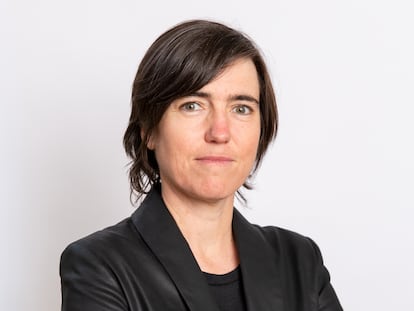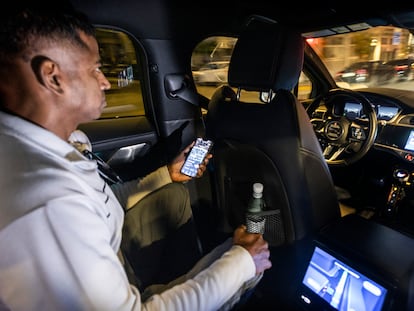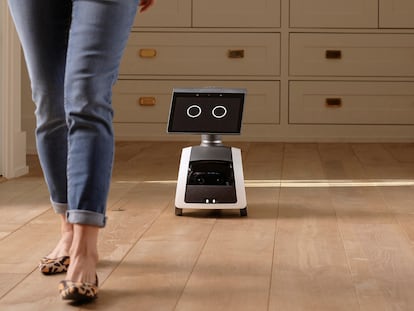Raquel Urtasun, the engineer who believes she has found the key to self-driving cars: ‘I have no doubts’
The first generation of driverless vehicles has failed to catch on. But after 15 years of research, this Spanish engineer has founded a company in Canada that she sees as the solution: ‘We have the advantage of being second’

This past August, the city of San Francisco approved the circulation of driverless taxis. Since then, disasters have followed: cars have ended up on the sidewalk, arrests have been carried out in the middle of the road… and there was even an accident. This ultimately resulted in one of the companies — Cruise — departing from the city. By November, Kyle Vogt, the firm’s CEO, had resigned. And, more broadly, just a couple of days ago, Tesla had to recall more than two million cars due to failures in its autopilot system.
Meanwhile, Spanish engineer Raquel Urtasun looks at this panorama with the calm of having a different technological solution for driverless cars. Urtasun, 47, created a startup in Toronto in 2021. She frequently appears on lists of the most influential personalities in the field of artificial intelligence… and she’s not the only one who believes that she has an alternative to the problem at hand.
Her company, Waabi, received $83 million in its first round of funding — a record in Canadian history. Waabi focuses on self-driving trucks. Trailers with the firm’s software are already circulating in test drives on the roads of Texas. “We’ve gone very fast,” Urtasun notes.
😬 @Cruise self-driving operations had a complete meltdown earlier in North Beach. We overheard on the scanner that all Cruise vehicle agents were tied up at the time (not literally) and so North Beach was going to get a delayed response. But wow, WTF!pic.twitter.com/D89xrSxAdu
— FriscoLive415 (@friscolive415) August 12, 2023
She’s been in Canada for 25 years. During her interview with EL PAÍS — conducted via videoconference from Toronto — she spoke in English. “I don’t remember how you say [certain] things in Spanish.” Urtasun is also a professor at the University of Toronto, where she once directed “the laboratory that’s considered to be the best in the world in autonomous driving.” And, before Waabi, she was in charge of self-driving at Uber, which has since closed that division. Urtasun believes that the second generation she leads will solve the problems that the first generation companies encountered on the streets of San Francisco.
“One of the reasons why I’ve been dedicated to autonomous driving for 15 years is because I know many people who’ve had severe traffic accidents. That motivates me. It’s an obsession, it’s not just another problem. Two million people die every year [from car accidents]... imagine the impact you can have. It’s very close to my heart and that’s why I’ve dedicated my entire career to solving this problem,” the engineer says.
Question. Why is it that we still don’t see self-driving vehicles everywhere?
Answer. The industry today has consolidated the so-called “version 1.0,” which is an engineering approach that requires [a test car] to drive for many miles, to see what new extraordinary situations the vehicle will encounter. Once the car has observed them, you have to adjust the system by hand, to resolve issues and continue testing. In the end, [the researchers are] at the mercy of nature [when it comes to knowing] which situations the car can take on and which it cannot. It’s a very slow process. Each new situation is more difficult to decipher. The industry has actually stopped in terms of progress. We’re not even at level 4 (level 5 would be that the car drives itself entirely without humans, while level 4 implies self-driving in a very restricted environment). There’s no autonomous truck out there beyond what you see in a demo.
Q. But there are a few self-driving cars on the streets…
A. Yes, robotaxis. But that’s a small deployment and it requires a lot of remote human intervention. It’s exciting that there’s a deployment, but we’re still far from having robotaxis everywhere. It’s the same with trucks: there’s not a single deployment without humans. The industry has consolidated, but we need a big technological change to take it forward at scale.
Q. And what change is that?
A. I call it “AI first,” for lack of a better name. And, thanks to OpenAI, today, we can call the technology that we’ve been developing for two-and-a-half years “generative AI.” But everyone understands me when I say “AI first.” [With this technology], you can move much faster towards the goal of marketing at scale. That’s the key that will enable a future of self-driving vehicles.
Q. Is that what Waabi does?
A. Yes, that’s why I founded a company. There’s no better way to build new technology than creating a company from scratch.
Q. And what system is being used by the other self-driving cars that are already circulating?
A. They’re very different. Waymo, Cruise, Aurora and Zoox have an engineering approach, where [their cars] have bits of AI, but they don’t deploy all their power. We, on the other hand, have built a single AI system in which the decisions can be traced, which is very important from a security point of view. That’s very different from what you see in the more traditional and consolidated approach [that’s prevalent] in the industry.
Q. When did you decide to look for another approach?
A. I’ve been working with AI for 25 years. Before Waabi, it was this complex system where you tried to add more and more bits of AI. With Waabi, what drives our trucks is a foundational model, a single AI system, which can do all the tasks that are required for driving. It’s very different. In 2018, I said that this was the direction I thought we should take. Now, we’re executing that vision, instead of taking something and moving it step by step towards the goal, which would take us a lifetime to reach. I saw that the revolution wasn’t going to happen in an existing company.
Q. Now you have no doubts about your direction?
A. I have no doubts. We have the advantage of being second. Our competitors have invested billions of dollars in generative technology… but from an older generation.
Q. And they can’t change anymore?
A. They can’t. They’d have to change the entire DNA of their companies. What are they going to tell their shareholders? “Wait, give me two years and I’ll show you this new generation.” That’s precisely why I founded the company. They’re not going to change. We now see that this is the correct approach.
Q. At what stage is Waabi at now?
A. In development, we have a test driver for safety purposes, who can take control if necessary. This is for level 4. This means that, when we’re ready, there will be no driver in the truck.
Q. Along with the foundational model with AI, what else does Waabi contribute?
A. The simulator. We’ve used generative AI to develop something that’s like the real world. That way, you don’t need to log all those real-world miles. You solve the data problem. This has been a huge step.
Q. On several occasions, you’ve said that a machine doesn’t need common sense or advanced intelligence to drive.
A. Humans are extraordinary. We have the ability to generalize and do many tasks with very few [test runs]. That’s typically very difficult for machines. To achieve better autonomous driving, we don’t have to solve all human capabilities. We don’t have to get to artificial general intelligence.
Q. And how good is a machine at driving?
A. A machine can, in theory, perform much better [than us]. They’re equipped with sensors that humans don’t have: they see 360 degrees all the time, they can potentially see further away [and they] perceive better in three dimensions. Humans have a narrow field of vision. In a complex city, so many things happen that you cannot keep an eye on everything… and that’s how most accidents occur. A high percentage is due to human error, plus distractions.
Q. Why did you choose trucks?
A. At Uber, I worked on cars and trucks. One thing was clear that, from a commercial point of view, the transportation industry is [in trouble]. The lack of drivers is real. The average age of truck drivers continues to grow. Two decades ago, it was 35. Today, it’s 55. Nobody wants to take those long road trips. It’s a very hard life. Companies need to deploy many more transportation routes.
Q. Was it just a commercial decision or also a technological one?
A. Also technological. This driving mostly takes place on highways. It’s easier than in cities. And there are other reasons: I started the company during the pandemic, when we saw how the supply chain affects all of us. There’s also a climatic reason: emissions from the trucking industry are large. Today, between 20% and 30% of trucks travel while empty. We can do much better to optimize [the system] and [create] a better future.
Q. That’s the commercial part. But you’re still a professor, you publish academic articles non-stop. How confident are you in your commitment as a scientist?
A. Everything we do in the company is data-driven and very scientific. I’m very, very confident. This is the technology that will solve [our transportation problems].
Q. Was this already taking place at Uber?
A. This challenge is completely new. We’re placing a bet on this technology.
Q. And how are you able to see what happens inside the famous AI black box?
A. If you look at a typical large language model, you’ll see a huge transformer with a billion parameters. That’s a black box. [Our] technology isn’t that. Our technology is a single system, but as it’s able to reason, it creates interpretable, intermediate representations. It does this in a way that can guarantee security. Our system thinks of ways to interpret, validate and verify, which, for large language models, is secondary. For us, it was [central to] the design of our original model. It’s a very different architecture. This is where our secret sauce gets started.
Q. Was the arrival of ChatGPT a surprise for you? And what effect has it had on language?
A. The digital world is much simpler than the physical one. Language is digital: how we communicate, how we write, how we interact. It’s clear that it’s incredible what these [large language] models can do. It’s been very exciting to see the changes in so many industries, in productivity, the new ways of interaction between humans and machines. Now, [in some fields], some mistakes aren’t so important. But in safety-critical applications, that’s not enough. You need 100% security. The revolution in the physical world hasn’t happened yet, but we’re the providers of that technology [in the digital world].
Q. ChatGPT only seems able to appear intelligent.
A. It can totally fool people into thinking that it’s intelligent in conversation. It’s very fluid. That’s why it may seem like it is general artificial intelligence… but it’s not. It’s still a primitive AI system compared to general AI. Although it’s still much better than what existed before.
Q. In 2019, you said that there were more ways than just the human way to achieve intelligence: “The human brain demonstrates the existence of a brain that cannot be artificially replicated. It has extreme intelligence… but this doesn’t mean that it’s the only way to achieve it.” How do you feel about your comments today?
A. In our founding AI model, common sense emerges. It’s very interesting, it’s able to learn.
Q. What do you mean by “common sense” in this context?
A. Understanding things like traffic rules, how different [drivers] behave. [This comprehension] emerges naturally, automatically. Even with road data, it learns the concepts of objects, how they move, without us having to program it by hand, which is the traditional method. It’s very intriguing and exciting.
Q. As a scientist, do you see it as feasible for your system to be able to learn in the same way a human learns?
A. I don’t know. I’m a very pragmatic scientist. I’m very focused on what the biggest obstacles are in the world today and how we solve them with technology. I’m not focused on whether we can build such a machine. I’m keeping my feet on the ground.
Sign up for our weekly newsletter to get more English-language news coverage from EL PAÍS USA Edition
Tu suscripción se está usando en otro dispositivo
¿Quieres añadir otro usuario a tu suscripción?
Si continúas leyendo en este dispositivo, no se podrá leer en el otro.
FlechaTu suscripción se está usando en otro dispositivo y solo puedes acceder a EL PAÍS desde un dispositivo a la vez.
Si quieres compartir tu cuenta, cambia tu suscripción a la modalidad Premium, así podrás añadir otro usuario. Cada uno accederá con su propia cuenta de email, lo que os permitirá personalizar vuestra experiencia en EL PAÍS.
¿Tienes una suscripción de empresa? Accede aquí para contratar más cuentas.
En el caso de no saber quién está usando tu cuenta, te recomendamos cambiar tu contraseña aquí.
Si decides continuar compartiendo tu cuenta, este mensaje se mostrará en tu dispositivo y en el de la otra persona que está usando tu cuenta de forma indefinida, afectando a tu experiencia de lectura. Puedes consultar aquí los términos y condiciones de la suscripción digital.
More information
Archived In
Últimas noticias
Trump traveled on Epstein’s plane ‘many more times’ than previously thought, according to new documents
Venezuelan exiles in Madrid scramble to salvage Christmas plans after flight cancellations
Russian ultranationalism, inflamed by the killing of the hooligan commander ‘Spaniard’
The relentless struggle between factions deepens the Sinaloa war: bodies in coolers and a surge in homicides
Most viewed
- The low-cost creative revolution: How technology is making art accessible to everyone
- Christian Louboutin: ‘Young people don’t want to be like their parents. And if their parents wear sneakers, they’re going to look for something else’
- All the effects of gentrification in one corner of Mexico’s Colonia Roma
- Liset Menéndez de la Prida, neuroscientist: ‘It’s not normal to constantly seek pleasure; it’s important to be bored, to be calm’
- Christmas loses its festive spirit: ICE fears cast shadow over religious celebrations











































